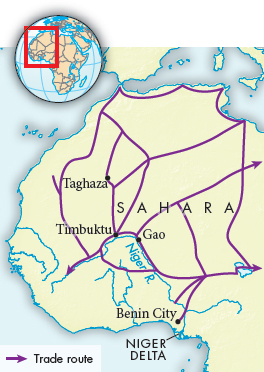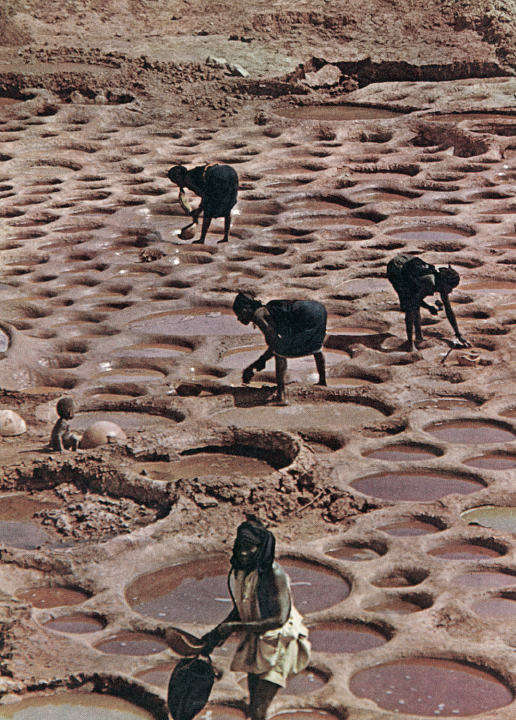Understanding World Societies:
Printed Page 590
Chapter Chronology
Trade and Industry

West African Trade Routes
As in all premodern societies, West African economies rested on agriculture. There was some trade and industry, but population shortages encouraged local self-sufficiency, slowed transportation, and hindered exchange. There were very few large markets, and their relative isolation from the outside world and failure to attract large numbers of foreign merchants limited technological innovation.
For centuries black Africans had exchanged goods with North African merchants in centers such as Gao and Timbuktu. This long-distance trans-Saharan trade was conducted and controlled by Muslim-Berber merchants using camels. The two primary goods exchanged were salt, which came from salt mines in North Africa, and gold, which came mainly from gold mines in modern-day Mali, and later, modern Ghana.

Salt Making in the Central Sahara
For centuries camel caravans transported salt south across the Sahara to the great West African kingdoms, where it was exchanged for gold. Here at Tegguida-n-Tessum, Niger, in the central Sahara, salt is still collected by pouring spring water into small pools dug out of the saline soil. The water leaches out the salt before evaporating in the desert sun, leaving deposits of pure salt behind, which are then shaped into blocks for transport. (Afrique Photo, Cliché Naud/Visual Connection Archive)
As elsewhere around the world, water was the cheapest method of transportation, and many small dugout canoes and larger trading canoes plied the Niger and its delta region (see Map 20.1). On land West African peoples used pack animals rather than wheeled vehicles; only a narrow belt of land in the Sudan was suitable for animal-drawn carts. When traders reached an area infested with tsetse flies, they transferred each animal’s load to human porters. Such difficulties in transport severely restricted long-distance trade, so most people relied on the regional exchange of local specialties.
West African communities had a well-organized market system. At informal markets on riverbanks, fishermen bartered fish for local specialties. More formal markets existed within towns and villages or on neutral ground between them. Markets also rotated among neighboring villages on certain days. Local sellers were usually women; traders from afar were men.
The salt trade dominated the West African economies in the fifteenth, sixteenth, and seventeenth centuries. The main salt-mining center was at Taghaza (see Map 20.1) in the western Sahara. In the most wretched conditions, slaves dug the salt from desiccated lakes and loaded heavy blocks onto camels’ backs. Tuareg warriors and later Moors (peoples of Berber and Arab descent) traded their salt south for gold, grain, slaves, and kola nuts. Cowrie shells, imported from the Maldives in the Indian Ocean by way of Gujarat (see “Merchant Networks in Islamic Empires” in Chapter 17) and North Africa, served as the medium of exchange. Gold continued to be mined and shipped from Mali until South American bullion flooded Europe in the sixteenth century. Thereafter, its production in Africa steadily declined.
West African peoples engaged in many crafts, such as basket weaving and potterymaking. Ironworking became hereditary in individual families; such expertise was regarded as family property. The textile industry had the greatest level of specialization. The earliest fabric in West Africa was made of vegetable fiber. Muslim traders introduced cotton and its weaving in the ninth century.
What role did trade play in West African society?

